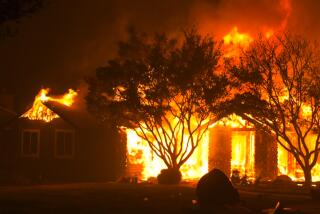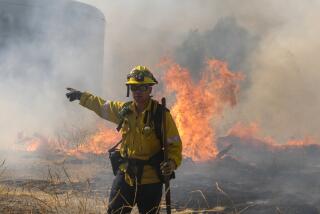A LOOK AHEAD * With up to 177,000 homes and businesses facing additional insurance costs until a major project increases the capacity of the Los Angeles River . . . New Flood Zone Is Awash in Anger
Nobody told the Lopez family there was a risk that the two-bedroom duplex they bought in Lynwood might someday stand in six feet of water.
Five years ago, as the family carefully calculated whether they could afford the mortgage payments, nobody told them they would someday be required to buy flood insurance to offset that risk.
Then, on Wednesday, the Lopezes learned that like thousands of other home and business owners in Southeast Los Angeles County, they are about to be forced to buy federal flood insurance.
Federal officials fear that the Los Angeles River and its tributaries no longer adequately protect 66 square miles of the region in the event of a 100-year flood, and they do not want to face the possibility of paying out millions of dollars in disaster aid.
So on July 6, Cesar and Carlota Lopez, and about 500,000 other residents, will find themselves in a federal flood-hazard zone. And from that day, nearly all mortgage owners in the area will be required to buy federal flood insurance.
Like many of their low- to moderate-income neighbors, the Lopezes say they don’t have the hundreds of dollars a year they must pay to insure their home against flooding.
“I can’t afford it,” said Carlota Lopez, who, with her three children and husband, lives on the roughly $400 a week her husband earns at a paper factory. “The money my husband makes is barely enough to pay the bills and buy food.”
But the Lopez family has little choice.
They live only a few hundred yards from the Los Angeles River.
In the late 1960s, Congress decided that people in officially designated flood zones should bear the burden of salvaging their drenched homes and businesses.
Anyone in a flood zone who has a mortgage that is regulated by the federal government--and that includes some 95% of all mortgages--will have to buy the insurance.
The new zone will include an estimated 177,000 homes and businesses in 14 communities and cities, from Pico Rivera to Long Beach.
Property owners in the zone will be able to buy cheaper flood insurance before the zone takes effect and lock future premiums in at that lower rate. However, they must pay for a year’s insurance up front, which can run from about $91 to $454, depending on the amount of coverage. After the zone is established on July 6, insurance rates could more than double.
If property owners refuse to buy insurance, their lender can purchase insurance for them at a higher price and pass on the cost.
The insurance will remain mandatory until the county and the U.S. Army Corps of Engineers finish a $240-million project to improve flood protection for the region. How long that takes will depend on how much Congress allocates for the project in the next few years.
Federal Emergency Management Agency officials say they and the affected cities have spent the past eight months distributing thousands of bulletins, holding dozens of neighborhood meetings and placing radio and newspaper ads to warn people about the new zone. They acknowledge, however, that they may not have reached everyone.
Some residents say they are only just now hearing about the mandatory insurance. Many are furious and say that nearby flood channels have never burst their banks.
“It’s a tremendous rip-off,” said Jack Reed, adding that his Long Beach home has not suffered flooding in the 33 years he has lived there. “There’s less chance of my property being destroyed by flood than being turned to ash by a Chinese missile.”
Rising Tide of Dissent
Reed was one of dozens of angry residents who assailed FEMA officials and politicians at a recent town hall meeting to discuss the issue in Long Beach. In Lynwood two weeks ago, about 100 people protested outside City Hall against the insurance.
“If they make us pay that money, a lot of people are going to lose their homes,” said Angel Cervantes as he waited for an explanation from city officials. “It’s a waste of money. We’re not in a flood zone.”
City officials also have weighed in against the mandatory insurance. Lakewood’s mayor, Larry Van Nostran, has called it a “flood tax” that would suck money out of the local economy.
“Most of us in the area consider it nothing less than raping our resources,” he said.
Critics, like Van Nostran, complain that FEMA is extorting premiums from areas that never flood so that the agency can pay off claims from disaster-prone areas, like Northern California and the Midwest.
But FEMA is just doing what Congress asked it to do, said Jack Eldridge, chief of FEMA flood programs for Los Angeles County.
Besides, he argued, compared with other types of private insurance, federal flood insurance is a good deal. The federal government charges relatively light premiums. And because flood improvements are underway, property owners will not have to face the higher premiums and stricter restrictions on new construction imposed on most flood zones.
FEMA and officials from the affected areas have encouraged property owners to buy insurance at the cheaper rate before the new flood zone becomes official, Eldridge said. Homeowners who cannot afford to insure the full value of their properties can buy a minimum level of insurance at a “preferred risk” discount for the first year. Then they will lock in their insurance at the low rate and can boost their coverage when they have the money, Eldridge said.
Many homeowners say they will refuse to pay the insurance on principle, but that could prove expensive. Mortgage lenders can be fined if they do not insist on insurance for borrowers, so lenders will buy policies and pass on the cost to borrowers. This “forced-placed” insurance could be more than three times the price of policies bought before July 6, according to FEMA.
Property owners who refuse to buy insurance also run the risk of seeing their possessions devastated by flood--a slim but very real threat, Eldridge said.
“The potential is really there,” he said. “People don’t want to believe it. They are in denial.
“What we’re talking about is major flood events, not the kind of rain you get every year. These major flood events will happen in every major watershed, and when they happen, that’s what residents say: ‘I’ve lived here for 50 years and nothing like that has ever happened.’ It is a shock . . . but there is an inevitability that these things will happen.”
Engineers Question River’s Effectiveness
Today’s intricate system of flood channels was built after the devastating flood of 1938, which killed 49 people and caused what today would be almost $800 million in damages, according to the U.S. Army Corps of Engineers. Since its completion in the late-1960s, the channel has kept areas along the lower reaches of the river safe from flooding.
But the corps made a discovery nearly two decades ago that raised questions about the river’s ability to protect surrounding neighborhoods. Storm water, engineers found, had left debris along the top of the river’s walls, so the corps began to investigate.
Studies showed that the designers of the channels had underestimated the extent and speed of urban development in the San Fernando Valley.
The Valley’s undeveloped lands once protected the lower reaches of the county by soaking up runoff from the Santa Monica Mountains when storms struck. But as citrus groves and farmlands rapidly became offices and tract homes, rainwater had nowhere to go but into the storm drains and other creeks that feed the Los Angeles River.
The studies showed that the river no longer meets minimum standards for flood protection, said Chris Stone, of the county’s public works department.
If a series of ferocious storms hit the region and the levees fail to hold, water would top the river’s banks, erode the back of the embankments and send a torrent of water into homes, businesses and across freeways, Stone said.
The county and the corps recommended a controversial plan to shore up 23 miles of the Los Angeles River, the Rio Hondo channel and Compton Creek by raising concrete walls and reinforcing embankments. Environmentalists decried the project. The designers, they argued, missed a unique opportunity to create a more natural river, one that would provide scenic waterways and animal habitats as well as flood protection. The project should be redesigned, they said.
But officials from cities in the flood zone objected. If more time was spent redesigning the project, it would be at the expense of those who must carry the burden of buying insurance and live under the threat of flooding.
Federal Funds Gain Momentum
Environmentalists agreed to drop a lawsuit against the project in return for the creation of a watershed task force to review alternatives to the plan. Last year, the task force endorsed the project--though many environmentalists remain opposed.
Today, nearly a third of the project is finished, and the county has set aside its portion of the funding for the rest. But completion still depends on the generosity of the White House and Congress, which have promised to pay 75% of the costs.
For each of the last two years, the White House proposed $11 million for the project. At that rate, construction will take more than a decade, county and city officials complain.
Last year, Congress bumped the figure to $21 million. This year, local congressional representatives are pushing colleagues to recommend even more.
So far, their lobbying has worked. Nearly two weeks ago, the Senate backed $40 million in funding. Last Monday, the House approved $60 million. At the House’s rate of funding, the project could be finished in three to four years, officials say.
A conference committee will hammer out a final figure sometime before the federal budget’s October deadline. Until then, officials from cities in the new zone are lobbying for generous funding for the flood control improvements.
The sooner the project is completed, they say, the sooner the double burden of flood insurance and the threat of devastating floods will end.
(BEGIN TEXT OF INFOBOX / INFOGRAPHIC)
Flood Zone
About 66 square miles of southeast Los Angeles County is about to be included in an new federal flood-hazard zone. Officials contend that the Los Angeles River and its tributaries no longer adequately protect the area against major flooding. Once the zone takes effect on July 6, many owners of homes and businesses in the area will be required to buy federal flood insurance at roughly twice the current price.
Sources: FEMA, L.A. County Dept. of Public Works, Army Corps of Engineers.
(BEGIN TEXT OF INFOBOX / INFOGRAPHIC)
Where to Call
To find out if your property is in the new federal flood zone, contact your city government or county offices. For information about federal flood insurance, call the National Flood Insurance Program hotline at (800) 720-1093 or (800) 427-4661.
More to Read
Sign up for Essential California
The most important California stories and recommendations in your inbox every morning.
You may occasionally receive promotional content from the Los Angeles Times.










